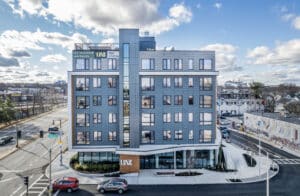
Boston’s newest co-living complex opened in January at 525 Lincoln St. in Allston, containing 278 bedrooms in a mixture of shared suites and conventional apartments. Photo courtesy of HDS Architecture
If free time is the ultimate luxury, it’s no surprise that Boston’s initial experiments in co-living developments are fetching premium rents.
At the 525 Linc complex in Allston and 7Ink in South End, residents pay above-market rents but receive perks such as housekeeping and all-inclusive utilities in return. Both complexes include both conventional apartments and those with up to four bedrooms sharing kitchens and living rooms.
Since receiving a certificate of occupancy in late December, the 525 Linc complex has leased more than 20 percent of its units in what is typically a slow time of year for apartment moves, said Benjamin Moll, a principal at ARX Urban in Newton which co-developed the project with Boylston Properties. Most of the residents are out-of-staters.
“That’s what we expected, because this is the perfect place for folks moving here whether it’s for a graduate program, or a new job or to work at a hospital,” Moll said.
It’s been a similar experience at 7Ink, Boston’s first co-living complex which opened in 2022, attracting primarily a 22-to-30-year-old cohort of tenants and a high percentage of newcomers to Boston, said Ted Tye, managing partner at National Development.
Developers marketed the 14-story tower overlooking the Southeast Expressway as a friction-free moving experience, eliminating trips to IKEA for furniture while providing a built-in support system of community activities for newcomers.
“One of the things that people move for is the social engagement, so we do constantly switch it up,” Tye said.
Twice-weekly housekeeping services and inclusive WiFi, TV and kitchen supplies add a hospitality element.
The premium for curated living? 7Ink currently is asking nearly $3,000 for a bedroom in a four-bedroom, 954-square-foot suite, and the complex is nearly 90 percent occupied. 525 Linc is marketing individual bedrooms in shared suites starting at $1,900.
Acknowledging the unusual management model at an emerging property type, National Development originally partnered with an outside co-living operator, Ollie. But it brought management of 7Ink in-house after COVID-19 disrupted the industry and forced a wave of consolidation among operators. It’s now bringing its practices learned at 7Ink to 525 Linc, where ARX Urban and Boylston Properties sought to partner with an experienced local operator.
During the depths of the pandemic, several national startups specializing in management of co-living properties scaled back their expansion and one, Quarters, filed for bankruptcy.
Boylston Properties and ARX Urban, co-developers of 525 Linc, originally had partnered with New York-based Common Co-Living as management company but switched to National Development Communities before the complex opened last month.

National Development originally partnered with an outside co-living operator for its 7Ink project in Boston’s South End. But it brought management in-house after COVID-19 disrupted the industry. Photo courtesy of National Development
National Development Communities, the company’s management arm that oversees a group of apartment complexes in the Boston area, oversees the social activities calendar at 7Ink. Residents opting to live in shared suites can coordinate with friends or use a roommate-matching app.
“National Development has ironed out the kinks on their project at 7Ink and figured it out,” Moll said.
Designing for Connectivity in Allston
Combining elements of college dorms, extended-stay hotels and corporate housing, co-living projects appear to be a natural growth niche in Boston with its generous share of graduate students and visiting researchers.
For Cambridge-based HDS Architecture, the 525 Linc project was a proving ground for optimizing shared housing design despite the Lincoln Street property’s physical limitations.
The design team’s goal: to create an attractive living environment including 278 bedrooms on a three-quarter-acre former parking lot surrounded by busy streets.
“There are not too many examples of co-living locally, but in our opinion it identifies with what younger people want: connectivity,” said Hans Strauch, principal architect at HDS. The firm consulted outside specialists on the allocation and layout of individual, shared and common spaces.

Steve Adams
Developers who approach co-living as merely a chance to collect higher income by maximizing units per square foot will be disappointed, Strauch said.
“This is not like a normal apartment project where you can say, ‘Let’s build a bunch of units and see what the rental prices are, and back into a pro forma,” he said. “This is a much more complex type of project, but it has significant opportunities to be successful in repositioning the marketplace.”
A 5,000-square-foot ground floor common room is 525 Linc’s signature amenity space, including kitchenette, great room with open seating, banquettes and work-from-home cubicles. A roof terrace offers an elevated perspective on Cambridge Street and the Massachusetts Turnpike.
Future developers seeking to replicate the Allston and South End projects will be limited by Boston officials’ pause on compact living approvals. A pilot program by the Boston Planning & Development Agency waived minimum housing unit sizes in exchange for larger common areas, in an experiment on whether it would drive down rents. The agency suspended the pilot in May 2023, citing the need to review rents once projects opened before approving more.






